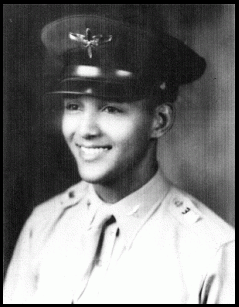Robert Friend (pilot)
Tuskegee airman and leader of Project Blue Book (1920–2019) From Wikipedia, the free encyclopedia
Robert Jones Friend (February 29, 1920 – June 21, 2019) was an American military officer and pilot who served with the Tuskegee Airmen during World War II and led the USAF's Project Blue Book from 1958 to 1963.[3][4] He also served during the Korean War and the Vietnam War. He had a 28-year military career.
Lieutenant Colonel Robert Friend | |
|---|---|
 | |
| Birth name | Robert Jones Friend |
| Nickname(s) | Bob |
| Born | February 29, 1920 Columbia, South Carolina, U.S. |
| Died | June 21, 2019 (aged 99)[1] Long Beach, California, U.S.[2] |
| Allegiance | United States of America |
| Service | United States Army Air Force |
| Years of service | 1943-1971 |
| Rank | Lieutenant colonel |
| Unit | 332nd Fighter Group |
| Awards |
|
| Spouse(s) |
Anna Rice
(m. 1959; died 2010) |
| Children | 8 |
Early life and education
Friend was born in Columbia, South Carolina on February 29, 1920. From an early age, he loved airplanes and wanted to sign up to fly for the army, but he was turned away because he was black. He attended Lincoln University in Pennsylvania and studied aviation.[1]
Military career
During World War II, Friend had 142 combat missions.[5] After the war began the Army established a segregated program for black pilots in Tuskegee, Alabama. Friend immediately signed up and completed training. The United States Army Air Corps commissioned him as an officer in the 332nd Fighter Group. He was sent to Africa and later Europe.[1]
After World War II, Friend stayed in the service and eventually served in the Korean and Vietnam Wars. He was in the military for a total of 28 years. He was a graduate of the Air Force Institute of Technology.[2]
Air Force study on UFOs
Friend said he believed in the possibility of extraterrestrial life in the universe. Friend led Project Blue Book, a classified U.S. Air Force study on UFOs. The project was started in 1952 and shut down in 1969 even though 701 documented incidents remain a mystery.[6]

Awards
- 2 Distinguished Flying Crosses (United States)
- Bronze Star Medal ribbon
- U.S. Army Presidential Unit Citation ribbon
- 3 U.S. Army Distinguished Service Medal ribbons
- The Air Medal
- Congressional Gold Medal awarded to the Tuskegee Airmen in 2006[7][1]
Death
Lt. Col. Friend died on June 21, 2019, in Long Beach, California at the age of 99 due to sepsis, according to his daughter. At the time, he was one of 12 remaining Tuskegee Airmen.[8][9] He had flown 142 combat missions in World War II as part of the elite group of fighter pilots trained at Alabama's Tuskegee Institute. A public viewing and memorial was held at the Palm Springs Air Museum on July 6.[10] He had spoken about his experiences in many different events prior to his death, such as in John Murdy Elementary School's "The Gratitude Project" in Garden Grove.[11]
See also
References
External links
Wikiwand - on
Seamless Wikipedia browsing. On steroids.
